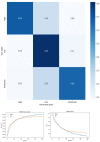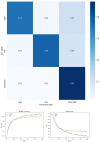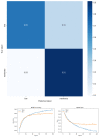Classification of Center of Mass Acceleration Patterns in Older People with Knee Osteoarthritis and Fear of Falling
- PMID: 36232190
- PMCID: PMC9564608
- DOI: 10.3390/ijerph191912890
Classification of Center of Mass Acceleration Patterns in Older People with Knee Osteoarthritis and Fear of Falling
Abstract
(1) Background: The preoccupation related to the fall, also called fear of falling (FOF) by some authors is of interest in the fields of geriatrics and gerontology because it is related to the risk of falling and subsequent morbidity of falling. This study seeks to classify the acceleration patterns of the center of mass during walking in subjects with mild and moderate knee osteoarthritis (KOA) for three levels of FOF (mild, moderate, and high). (2) Method: Center-of-mass acceleration patterns were recorded in all three planes of motion for a 30-meter walk test. A convolutional neural network (CNN) was implemented for the classification of acceleration signals based on the different levels of FOF (mild, moderate, and high) for two KOA conditions (mild and moderate). (3) Results: For the three levels of FOF to fall and regardless of the degree of KOA, a precision of 0.71 was obtained. For the classification considering the three levels of FOF and only for the mild KOA condition, a precision of 0.72 was obtained. For the classification considering the three levels of FOF and only the moderate KOA condition, a precision of 0.81 was obtained, the same as in the previous case, and finally for the classification for two levels of FOF, a high vs. moderate precision of 0.78 was obtained. For high vs. low, a precision of 0.77 was obtained, and for the moderate vs. low, a precision of 0.8 was obtained. Finally, when considering both KOA conditions, a 0.74 rating was obtained. (4) Conclusions: The classification model based on deep learning (CNN) allows for the adequate discrimination of the acceleration patterns of the moderate class above the low or high FOF.
Keywords: acceleration; deep learning; fall; gait; knee osteoarthritis; preoccupation.
Conflict of interest statement
The authors declare no conflict of interest.
Figures









Similar articles
-
Association of fear of falling with acceleration-derived gait indices in older adults with knee osteoarthritis.Aging Clin Exp Res. 2019 May;31(5):645-651. doi: 10.1007/s40520-018-1022-x. Epub 2018 Aug 20. Aging Clin Exp Res. 2019. PMID: 30128664
-
Factors associated with fear of falling in older women with knee osteoarthritis: A cross-sectional study.Geriatr Nurs. 2024 Jan-Feb;55:333-338. doi: 10.1016/j.gerinurse.2023.12.018. Epub 2023 Dec 27. Geriatr Nurs. 2024. PMID: 38154414
-
Fear of falling in community-dwelling older adults: What their gait acceleration pattern reveals.Comput Methods Programs Biomed. 2024 Feb;244:108001. doi: 10.1016/j.cmpb.2023.108001. Epub 2023 Dec 27. Comput Methods Programs Biomed. 2024. PMID: 38199138 Free PMC article.
-
Fear of falling and falls in people with multiple sclerosis: A literature review.Mult Scler Relat Disord. 2021 Jan;47:102609. doi: 10.1016/j.msard.2020.102609. Epub 2020 Oct 31. Mult Scler Relat Disord. 2021. PMID: 33189021 Review.
-
Disentangling interventions to reduce fear of falling in community-dwelling older people: a systematic review and meta-analysis of intervention components.Disabil Rehabil. 2022 Oct;44(21):6247-6257. doi: 10.1080/09638288.2021.1969452. Epub 2021 Sep 11. Disabil Rehabil. 2022. PMID: 34511009
Cited by
-
Improvement in Quality of Life with Use of Ambient-Assisted Living: Clinical Trial with Older Persons in the Chilean Population.Sensors (Basel). 2022 Dec 27;23(1):268. doi: 10.3390/s23010268. Sensors (Basel). 2022. PMID: 36616866 Free PMC article. Clinical Trial.
References
-
- Bloom D., Canning D., Lubet A. Global population aging: Facts, challenges, solutions & perspectives. Daedalus. 2015;144:80–92.
Publication types
MeSH terms
Grants and funding
LinkOut - more resources
Full Text Sources

